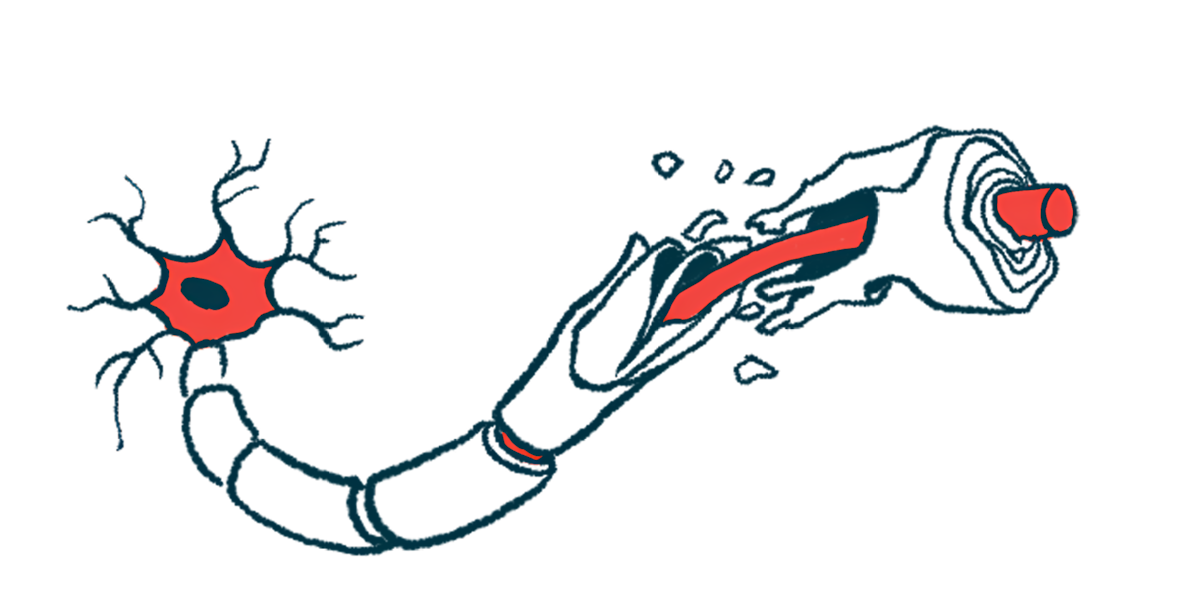Meds for myelin sheath repair may help limit nerve damage in MS
New analysis of old trial data shows potential of remyelination therapies
Written by |

Medications that can promote the repair of the myelin sheath — the protective coating around nerve cells in the body — may also help limit nerve damage in multiple sclerosis (MS), according to a new analysis of data from a small clinical trial testing an anticancer therapy called bexarotene for use in MS.
The study detailing these findings, titled “Serum neurofilament light chain levels suggest neuroprotection following bexarotene-induced remyelination in people with relapsing remitting multiple sclerosis,” was published in the journal Multiple Sclerosis and Related Disorders.
MS is characterized by inflammation in the brain and spinal cord, which damages the myelin sheath, a protective, fatty layer that surrounds nerve fibers and enables efficient transmission of electrical signals.
Currently available MS treatments can help tamp down inflammation to slow disease progression, but there are no therapies proven to promote myelin repair, known as remyelination.
Bexarotene is a compound that’s approved under the brand name
In the mid-2010s, a team led by scientists in the U.K. conducted a small Phase 2a clinical trial, called CCMR-One (ISRCTN14265371), testing bexarotene against a placebo in people with relapsing-remitting MS (RRMS). This MS type is marked by periods of new or worsening symptoms followed by remission periods where symptoms ease.
Although the study showed that bexarotene was associated with substantial side effects that made it ill-suited for use as a routine MS treatment, it also indicated that treatment with the cancer therapy reduced visual evoked potential (VEP) latency — a sign of remyelination based on how quickly nerve signals travel from the eyes to the brain.
Researchers examine data from trial testing cancer therapy for MS
In theory, increasing remyelination is expected to help limit nerve fiber damage in people with MS. However, there’s not much hard data to support this idea.
To help fill this gap, a research team from the University of Cambridge in the U.K. and the University of Basel and University Hospital Basel in Switzerland looked at data from the CCMR-One study.
Specifically, the team examined whether bexarotene treatment affected biomarkers of nerve damage. Their analysis used data from 27 participants, 15 who had been given bexarotene and 12 who had been given the placebo.
The results showed that, after six months, there were no significant differences between the bexarotene and placebo groups for any of the biomarkers assessed. Given the lack of major overall changes in the biomarkers, the researchers looked more closely at individuals who showed signs of remyelination after taking bexarotene.
Our findings did suggest that remyelination in response to bexarotene treatment may be associated with neuroprotection in people with [relapsing-remitting MS].
Among those treated with bexarotene, individuals who had greater reductions in VEP latency — which indicated remyelination — also showed a reduction in blood neurofilament light chain (NfL) levels, a marker of nerve damage. Put another way, among patients on bexarotene, those who showed signs of remyelination also tended to show signs of less nerve fiber damage. This relationship was not seen in the placebo group, the researchers noted.
“Our findings did suggest that remyelination in response to bexarotene treatment may be associated with neuroprotection in people with RRMS,” the researchers wrote, adding that other data from the study “[provide] additional support for the hypothesis that bexarotene confers neuroprotective effects through remyelination, an effect not observed in the placebo group.”
The researchers noted that this analysis was limited by the small number of patients in the trial and its short timeframe. Still, according to the team, these findings overall “[contribute] to the growing body of evidence supporting the potential of remyelinating therapies, such as bexarotene, to promote neuroprotection in people living with RRMS.”





